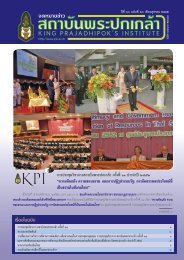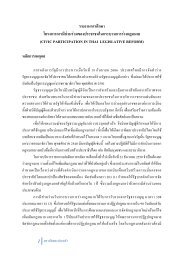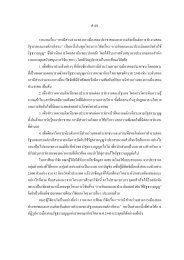SUFFiciENcy EcONOMy ANd GRASSROOtS DEvElOPMENt
SUFFiciENcy EcONOMy ANd GRASSROOtS DEvElOPMENt
SUFFiciENcy EcONOMy ANd GRASSROOtS DEvElOPMENt
Create successful ePaper yourself
Turn your PDF publications into a flip-book with our unique Google optimized e-Paper software.
270<br />
The Meaning of Sufficiency Economy <br />
International Conference<br />
The social benefits of renewable energy, which favors renewable energy<br />
adoption, include:<br />
• Provide clean, green, reliable, pollution free, low emission and distributed<br />
technology power<br />
• Saves from high-running cost of generator and increasing diesel cost<br />
• The hybrid system gives quality power out-put of 48 volt DC to charge<br />
directly the storage battery.<br />
• The system can be designed for both off-grid and on-grid applications.<br />
• Efficient and easy installation, longer life<br />
• Low gestation period<br />
• Low operating & maintenance cost<br />
However, electricity, unlike fuel, cannot be stock-piled. For the most part, it<br />
must be created at almost the instant it is consumed. And much electrical energy<br />
goes to waste, as when wind farms are taken offline because they are producing<br />
more electricity than is needed. (Korosec 2011) Industrial and academic researchers<br />
are trying to solve these problems with new large-scale energy storage technologies.<br />
Notable contenders include scaled-up lithium-ion batteries and liquid metal<br />
batteries. To date, lithium batteries have been relatively expensive and short-lived.<br />
To try to overcome these drawbacks, startup Seeo is replacing the batteries’ usual<br />
liquid electrolyte with solid polymers. As well as lasting longer, solid polymers<br />
allow the batteries to store more energy.<br />
To account for the savings on kerosene or firewood burnt, we take the help of<br />
our literature survey to support this fact. A survey (Singh 2011) had been carried out<br />
in a cluster of 5 villages in Badlapur block of Jaunpur District of eastern Uttar<br />
Pradesh in 2004. The cluster of villages chosen comprises of five villages viz<br />
Rampur, Dhiva, Chowkvia, Khetaria, Bahra. These villages are under Tiyara tahsil.<br />
There are 529 household in the cluster. From the survey, the present energy<br />
consumption pattern in cooking, lighting, other domestic activities, agriculture and<br />
allied activities, rural industry and transport has been worked out. Total firewood<br />
equivalent consumption of biomass fuels per household as calculated by the survey<br />
is 2.14 Ton/Yr. <br />
The survey (Singh 2011) covered the willingness of the villages to adopt the<br />
renewable energy systems instead of traditional devices. The following numbers of<br />
renewable energy systems as given in table 4 are proposed to be implemented in a<br />
period of five years in different villages of the cluster. In order to assess the benefits<br />
of the recommended systems the table also provides the cost benefit analysis in<br />
terms of energy saving in fuel utilization and also in monetary terms taking the<br />
firewood cost as Rs.1500/ton, cost of diesel as Rs. 35/l and the cost of electricity as<br />
3.75/kWh. Total energy saving in terms of wood equivalent will be 456.921tones/yr














